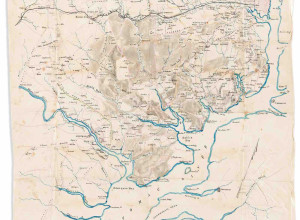The Morgan Library to Open "Medieval Monsters: Terrors, Aliens, Wonders" in June
 New York — From dragons, unicorns, and other fabled beasts to inventive hybrid creations, artists in the Middle Ages filled the world around them with marvels of imagination. Their creations reflected a society and culture at once captivated and repelled by the idea of the monstrous. Drawing on the Morgan Library & Museum's superb medieval collection as well as loans from New York’s Metropolitan Museum of Art and Boston’s Museum of Fine Arts, Medieval Monsters: Terrors, Aliens, Wonders—on view beginning June 8—examines the complex social role of monsters in medieval Europe. It brings together approximately seventy works spanning the ninth to sixteenth centuries, and ranging from illuminated manuscripts and tapestry to metalwork and ivory.
New York — From dragons, unicorns, and other fabled beasts to inventive hybrid creations, artists in the Middle Ages filled the world around them with marvels of imagination. Their creations reflected a society and culture at once captivated and repelled by the idea of the monstrous. Drawing on the Morgan Library & Museum's superb medieval collection as well as loans from New York’s Metropolitan Museum of Art and Boston’s Museum of Fine Arts, Medieval Monsters: Terrors, Aliens, Wonders—on view beginning June 8—examines the complex social role of monsters in medieval Europe. It brings together approximately seventy works spanning the ninth to sixteenth centuries, and ranging from illuminated manuscripts and tapestry to metalwork and ivory.
The show explores three key themes: “Terrors” demonstrates how monsters enhanced the aura of those in power, whether rulers, knights, or saints. “Aliens” reveals how marginalized groups in European societies—such as Jews, Muslims, women, the poor, and the disabled—were further alienated by being depicted as monstrous. The final section on “wonders” considers the strange beauties and frightful anomalies such as dragons, unicorns, or giants that populated the medieval world.
“In the medieval world the idea of the monstrous permeated every level of society,” said Colin B. Bailey, director of the Morgan Library & Museum, “from rulers, and the nobility and the clergy, to agrarian and urban dwellers alike. Artists of the Middle Ages captured this phenomenon in images of beings at once familiar and foreign to today’s viewer. We are grateful to our guest curators Asa Simon Mittman and Sherry Lindquist for helping us bring this engrossing subject to the public.”
The EXHIBITION
I. Terrors
Throughout the Middle Ages, rulers capitalized on the mystique of monsters to enhance their own aura of power. In medieval art, they often depicted themselves—or figures with whom they could identify—as righteous heroes demonstrating their worthiness by slaying the most frightful creatures imaginable. By embellishing all manner of luxury objects with monstrous imagery, the nobility and clergy could also reinforce and dramatize their own authority. Such fear some motifs were often thought to have not only a symbolic potency but also actual power in warding off evil.
Because of their ability both to terrify and to inspire awe, monsters could even be used to evoke the divine. From headless saints to three-headed trinities, these “sacred terrors” vividly bring to life the power of monsters to bridge the gap between the natural and the supernatural. Ultimately, the monsters in this section offer us a glimpse into how people in the Middle Ages perceived relationships of power, whether earthly or divine.
II. Aliens
In the modern world, the term alien is most strongly associated with extraterrestrials. In the Middle Ages, however, aliens were very much inhabitants of our world. Deriving from the Latin word for “foreign” or “exotic,” an alien was simply a person or thing from somewhere else. For medieval men and women, the various peoples thought to live on the other side of the world were just as unreachable, and therefore unknowable, as Martians would be to us. At times, these aliens were the subject of titillating speculation; other times they were sources of fear or objects of derision.
As in other eras, monstrous imagery could be used to stigmatize those perceived to deviate from the norm. This held true not only for “strangers” to medieval Christian societies—most notably, Jews and Muslims—but also for those who were marginalized within their own communities. Women, the poor, the mentally ill or physically impaired could all be made monstrous by medieval artists. Such representations helped define the difference between those who were accepted and those who were cast aside. Confronting these at times difficult images reminds us of the ability of the visual arts to shape our perceptions of others.
III. Wonders
For medieval viewers, monsters could also inspire a sense of wonder and marvel as a transformative response to strange, surprising, or mysterious phenomena. During the Middle Ages, wonders were only as significant as their authenticity, which could be confirmed either by eye-witness accounts or by the authority of venerable authors. The difficulty of disentangling truth from fiction became a common theme, giving rise to entire genres of text that claimed to catalogue the various phenomena of the world: from herbals and bestiaries to travel accounts.
Capable of shifting expectations and perceptions, monsters inspired viewers to reconsider their place in the world. These fantastical creatures were often so unpredictable and prevalent in the cultural imagination that it is often hard to judge whether they reinforce or disrupt the norms of the time. This exhibition invites visitors to consider what medieval monsters can teach us about the cultures that created them.
Publication
The accompanying catalogue, Medieval Monsters: Terrors, Aliens, Wonders, features full-page reproductions of 61 works in the exhibition, a Director’s Foreword by Colin B. Bailey, a preface by China Miéville, and essays by Sherry C. M. Lindquist and Asa Simon Mittman.
Author: Sherry C. M. Lindquist, Asa Simon Mittman
Publisher: The Morgan Library & Museum, in association with D Giles Limited.
175 pages.
Image: The Taming the Tarasque, from Hours of Henry VIII, France, Tours, ca. 1500. The Morgan Library & Museum, MS H.8, fol. 191v, detail. Photography by Graham S. Haber, 2013.















